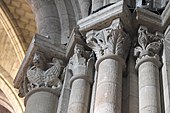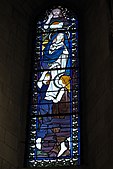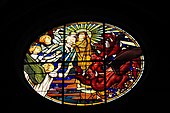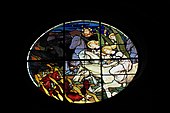Notre-Dame (Bougival)
The Catholic parish church of Notre-Dame ( Notre-Dame de l'Assomption ) in Bougival , a municipality in the Yvelines department in the French region of Île-de-France , dates back to a Romanesque church building from the 12th century. The church is dedicated to the Assumption of Mary. In 1862, the building was added to the list of architectural monuments in France as a monument historique .
history
The oldest parts of the church, the choir and the bell tower with its two chapels , which form the transept, date from the first half of the 12th century. In the 13th century, the eastern yoke of the three-aisled nave with a three-story elevation ( arcade zone , triforium and round window) was added in the Gothic style . In the 17th century, two more yokes followed, which were closed with a west facade. At the end of the 19th century, under the direction of the architect Lucien Magne, the nave was renewed based on the model of the 13th century yoke and extended by two more yokes, the transept, the choir and the bell tower were extensively restored. A rectory and a sacristy were built in the north of the church .
architecture
Exterior construction
The square bell tower, crowned with a stone pyramid roof, rises above the crossing . Its two floors are broken up on all four sides by high, arched sound arcades framed by archivolts and columns with capitals . The corners are decorated with round corner turrets supported by slender columns. Old corbels have been preserved under the roof of the apse . The portal of the west facade is decorated with a tympanum depicting a Madonna and Child surrounded by angels. A rose window is cut into the facade above the portal . A vestibule was added in front of the portal of the south facade in the 19th century.
inner space
The church, built on the plan of a Latin cross , has a three-aisled nave divided into five bays . The main and side aisles are covered by ribbed vaults. Wide, ogival arcades open to the side aisles , over which a triforium runs on both sides . Large round windows have been cut above it. The semicircular closed choir is covered with a mosaic on which symbols of the Virgin Mary are depicted.
Capitals
In the choir there are still capitals from the 12th century. They are decorated with plant motifs, figurative scenes and mythical creatures. A naked female figure is depicted on a capital with two snake-like creatures biting off the breasts.
Leaded glass window
Of the original five stained glass windows in the choir, only two have survived. They were designed in 1898 by Henri-Marcel Magne , the son of the architect Lucien Magne, and depict the Assumption of Mary and the Adoration of the Shepherds. The four windows in the transept were also designed by Henri-Marcel Magne and executed in 1900 by Charles Leprévost . They depict a fish under palm fronds, a lamb in front of ears of wheat, three pigeons with fig leaves and a peacock in front of vines.
The lead glass windows in the south aisle were made by Marcel Delon in 1904 based on designs by Henri-Marcel Magne. They represent the Bishop of Paris, Saint Marcellus , the Archangel Michael who defeated the dragon, the French King Louis the Saint in the port of Aigues-Mortes , Saint Avertin of Tours, the second patron saint of the Church, Anthony of Padua , who preaching to the fish and depicting St. Joseph with the baby Jesus in his arms.
Scenes from the Revelation of John are depicted on the round windows in the nave . The windows were designed by Henri-Marcel Magne and made between 1902 and 1904 by Hippolyte Théophile Laumonnerie and Charles Leprévost. Of the original ten discs, only five have survived. A window shows the apocalyptic woman who, surrounded by rays of the sun, holds a child in her arms and is threatened by a seven-headed dragon ( Rev 12 : 1-6 EU ). Another window shows a group of people bowing to wild animals ( Rev 13 : 1-10 EU ). On another window are shown riders clad in white robes who fight against beasts with lances ( Rev 19 : 11-21 EU ). On the other two remaining discs, the whore Babylon ( Rev 17.1–18 EU ) and the New Jerusalem ( Rev 21.9–27 EU ) are shown.
organ
The organ was created in 1905 in the workshop of Charles Mutin , the successor of Aristide Cavaillé-Coll , for the concert hall of the Union Chrétienne des Jeunes Gens in Paris and installed in 1945 by the organ builder Paul-Marie Koenig in the parish church of Bougival.
Further equipment
- The baptismal font is dated to the 13th or 16th century.
- In the church a marble plaque commemorates Rennequin Sualem († 1708), the builder of Marly's machine , who is buried in the choir.
literature
- Jean-Marie Pérouse de Montclos (ed.): Le Guide du Patrimoine. Île-de-France . Hachette, 2nd edition, Paris 1994, ISBN 2-01-016811-9 , p. 137.
- Georges Poisson (ed.): Dictionnaire des Monuments d'Île-de-France . Éditions Hervas, Paris 2001, ISBN 2-84334-002-0 , p. 131.
Web links
- Église paroissiale Notre-Dame in the Base Mérimée of the French Ministry of Culture (French)
- Église Notre-Dame de l'Assomption www.patrimoine-religieux.fr (French, accessed on November 22, 2018)
- Église Notre Dame de l'Assomption de Bougival Paroisse de Bougival (French, accessed November 22, 2018)
Individual evidence
- ↑ Église Notre-Dame in the Base Mérimée of the French Ministry of Culture (French)
- ↑ Les grandes Orgues de Notre-Dame de Bougival www.tourisme-bougival.com
- ↑ Fonts baptismaux in the Base Palissy of the French Ministry of Culture (French)
- ↑ Fonts baptismaux in the Base Palissy of the French Ministry of Culture (French)
Coordinates: 48 ° 51 ′ 48.2 " N , 2 ° 8 ′ 25" E


















